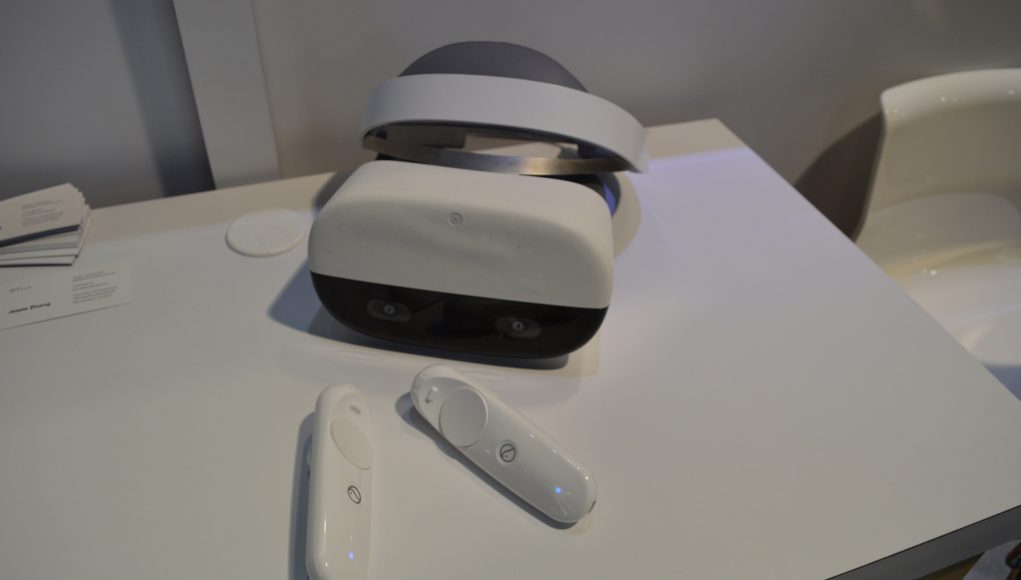When the China-based headset manufacturer Pico Interactive announced they were bringing their six degrees of freedom (6DoF) Pico Neo VR headset and 6DoF controllers to the West, it wasn’t clear what content store they’d be drawing from when they released the headset out of China. As it turns out, the company may beat HTC to the punch by being the first to bring Viveport mobile to the rest of the world—at least that’s the way it appears currently, as HTC hasn’t yet released word on a possible Western release for Vive Focus.
Sitting down with Pico’s VP of Business Development Paul Viglienzone, I was told the headset would be launching globally with the Viveport mobile store sometime in “late spring” following its invite-only business-to-business launch coming in a few weeks.
Unable to speak on behalf of HTC, Viglienzone couldn’t tell us if Pico Neo would be the first out of China to ship with Viveport mobile or not, but it’s certainly the first to announce its intentions to do so—meaning HTC’s mobile app store isn’t going to be beheld to the Chinese market as previously thought.
While the headset primarily serves 6DoF content, it can also technically switch into a ‘3DoF mode’ to play games designed for 3DoF input like those created for Vive Focus, giving it the hypothetical ability to have access to greater amount of content. The headset is said to deliver 70 games at launch, with the eventual addition of WebVR to the headset’s roadmap. It’s unclear if these launch day games will all be 6DoF however.
Here’s a quick hands-on with the headset:
Cinching the Neo’s halo strap onto my head, the headset itself proved to be both light and comfortable. In the bright lights of the conventional hall, I noticed minimal light bleed seeping in after I cranked the headset onto my noggin, a simple ratchet system, and pulled the display in closer to my face. Incorporating a Qualcomm Snapdragon 835 processor driving dual 3.5 inch LCD displays, each with 1440x 1600 screen resolution, the visual clarity was impressive. Without a scene with stark visual contrast (like white text on a back background), it wasn’t possible to tell just how good its near-circular fresnel lenses were, but I didn’t notice any overly obnoxious god rays to speak of in the brightly-colored demo.
Like Daydream, Gear VR and now Vive Focus, the Pico Neo controller features a trigger and touchpad. A home button sits below the circular trackpad with a tick-tack-shaped select button above. Ergonomically speaking, the controllers aren’t much to write home about though, as both left and right controllers are seemingly identical.
The demo I tried put a ray gun in one hand and a shield in the other, with a number of cutesy dragons firing lasers at your head. I could deflect the oncoming shots from the adorable baddies or dodge them entirely, using the headset’s 6DoF capabilities to its fullest.
While graphically simple, my experience with the headset wasn’t without its hitches unfortunately. Positional tracking was fairly reliable, although it was clear that latency is still an issue at this point. Walking from one side of the room to the other (both physically and virtually), I could feel the headset struggle to keep up as the ground visibly sloshed to follow my steps.
Motion controller tracking wasn’t comparable with what you’d find on any of the three major VR systems either. There, latency was also a pretty significant issue in maintaining 1:1 parity with my hands’ actual position, although I was reassured the controller latency would see greater polish in the consumer version. Using an ultrasonic solution sourced from Bay Area-based Chirp Microsystems, I had moments when the controllers seemed to follow my hands closely enough to be considered usable, but in its current state I couldn’t imagine using the controllers for fine object interaction like you would on any PC/console-based VR headset.
To track the controllers, which emit inaudible noise, the headset features three ultrasonic receivers embedded within; a small hole on either side of the the headset and a single in the top center. I was told the system’s ultrasonics were computationally cheaper than optical tracking like you might find in Windows ‘Mixed Reality’ VR headsets or more aptly Oculus’ Project Santa Cruz.
At Pico Neo’s $750 price tag and still somewhat squishy-feeling 6DoF-everything, it’s uncertain where the headset will land with consumers when it finally hits this spring. You can bet we’ll be following along though.
– – — – –
We have feet on the ground at CES this year, so check back for more hands-on, previews and all things virtual and augmented.







